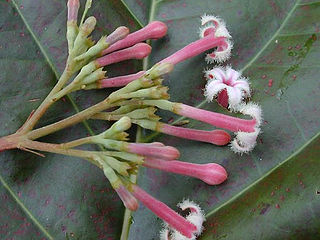
Quinine is a medication used to treat malaria and babesiosis. This includes the treatment of malaria due to Plasmodium falciparum that is resistant to chloroquine when artesunate is not available. While sometimes used for restless legs syndrome, quinine is not recommended for this purpose due to the risk of serious side effects. It can be taken by mouth or intravenously. Malaria resistance to quinine occurs in certain areas of the world. Quinine is also the ingredient in tonic water that gives it its bitter taste.

Cinchona is a genus of flowering plants in the family Rubiaceae containing at least 23 species of trees and shrubs. All are native to the tropical Andean forests of western South America. A few species are reportedly naturalized in Central America, Jamaica, French Polynesia, Sulawesi, Saint Helena in the South Atlantic, and São Tomé and Príncipe off the coast of tropical Africa, and others have been cultivated in India and Java, where they have formed hybrids.

The Bixaceae are a family of dicotyledonous plants commonly called the achiote family. Under the Cronquist system, the family was traditionally placed in the order Violales. However, newer arrangements move it, with some other families previously in the Violales, into the Malvales.

Bombax is a genus of mainly tropical trees in the mallow family. They are native to western Africa, the Indian subcontinent, Southeast Asia, and the subtropical regions of East Asia and northern Australia. It is distinguished from the genus Ceiba, which has whiter flowers.

QS-21 is a purified plant extract used as a vaccine adjuvant. It is derived from the soap bark tree, which is native to the country of Chile.

Ricinodendron is a plant genus in the family Euphorbiaceae first described as a genus in 1864. It includes only one known species, Ricinodendron heudelotii, native to tropical Africa from Senegal + Liberia east to Sudan and Tanzania and south to Mozambique and Angola. It produces an economically important oilseed. The tree is known as munguella (Angola), njangsa (Cameroon), bofeko (Zaire), wama (Ghana), okhuen (Nigeria), kishongo (Uganda), akpi, djansang, essang, ezezang and njasang. Two varieties of the tree species are recognized R. heudelotii var. heudelotii in Ghana and R. heudelotii var. africanum in Nigeria and westwards.

Entandrophragma is a genus of twelve known species of deciduous trees in the family Meliaceae.
Kapok tree can refer to several plants with seeds that grow long hairs:
Silk-cotton tree is a common name for several plants and may refer to:

The Cochlospermaceae were a family of two genera and 20-25 species of trees and shrubs, first described by Jules Émile Planchon in 1847. They have been included in the Bixaceae from the APG III system onwards. The older APG II system treated this family as an optional segregate of Bixaceae. They occur widely throughout the tropical regions of the world, but are curiously absent from Malaysia. Most species in this family are mesophytic or xerophytic, growing primarily in drier climates.

Cochlospermum is a genus of trees in the Bixaceae family; some classifications place this genus in the family Cochlospermaceae. It is native to tropical regions of the world, particularly Latin America, Africa, the Indian Subcontinent, and Australia.
Borotutu is traditional medicine made from the African tree Cochlospermum angolense. As the name indicates, it is widespread in parts of Angola, where it is known as mburututu in the Chokwe and Kimbundu languages.

The history of malaria stretches from its prehistoric origin as a zoonotic disease in the primates of Africa through to the 21st century. A widespread and potentially lethal human infectious disease, at its peak malaria infested every continent, except Antarctica. Its prevention and treatment have been targeted in science and medicine for hundreds of years. Since the discovery of the Plasmodium parasites which cause it, research attention has focused on their biology, as well as that of the mosquitoes which transmit the parasites.

Justus Carl Hasskarl was a German explorer and botanist specializing in Pteridophytes, Bryophytes and Spermatophytes. He was co-founder of the Society of Natural Curiosities of India, in Bavaria and spent his time researching flora of Indonesia for years.

Cochlospermum religiosum is a flowering plant from the tropical region of Southeast Asia and the Indian Subcontinent. It is a small tree growing to a height of 7.5 m (25 ft) usually found in dry deciduous forests. The name religiosum derives from the fact that the flowers are used as temple offerings. It is also known as silk-cotton tree because the capsules containing the seeds have a fluffy cotton-like substance similar to kapok. Another common name is buttercup tree because its yellow and bright flowers look like large-sized buttercups.

Cochlospermum regium, also known as yellow cotton tree, is a flowering plant that has its origins in the Cerrado tropical savanna of South America, but now it is also common in Southeast Asia.

Cochlospermum fraseri is a tree in the family Bixaceae with common names cotton tree, kapok bush, and kapok tree. It is native to north western Australia.

Cochlospermum gillivraei is a tree in the family Bixaceae, with the common name kapok. It is native to Northern Australia.

Cochlospermum vitifolium is a tree in the family Bixaceae. It is native to the Americas: from Mexico to Brazil.
Rinorea dentata, commonly known as kuntze, is a species of plant in the family Violaceae. It is found in the tropical rainforests of Liberia, Nigeria, Cameroon and Uganda. It is particularly common in the Omo Forest Reserve in Ogun State, Nigeria.














